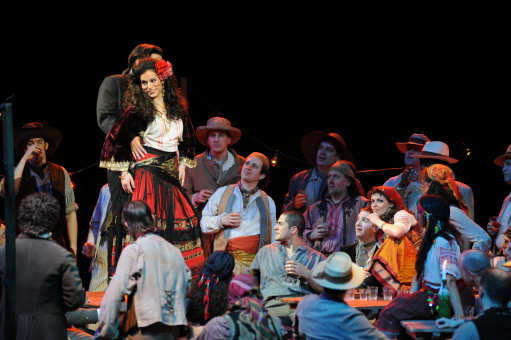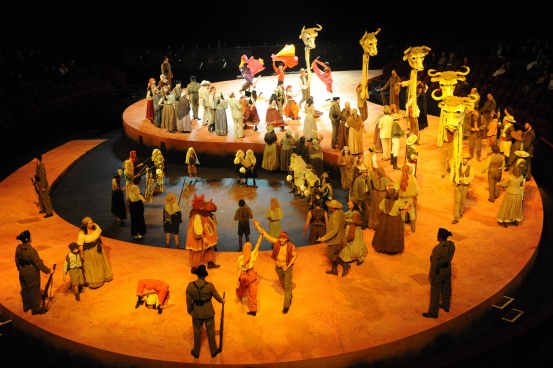Other Links
Editorial Board
-
Editor - Bill Kenny
-
Deputy Editor - Bob Briggs
Founder - Len Mullenger
Google Site Search
SEEN AND HEARD
UK OPERA REVIEW
Bizet, Carmen:
Soloists and
Chorus, Capital Arts Children’s Choir and Royal Philharmonic
Orchestra. Conductor: Peter Robinson. Royal Albert Hall,
London.
6.3.2009 (JPr)
I did not see this
Carmen in 2005 but returned to opera ‘in-the-round’ last year with Tosca
that I enjoyed, though with certain reservations. Carmen too was a
thoroughly enjoyable night at the opera for the near-capacity audience it
brought to the Royal Albert Hall. It is still not a cheap evening with the
distant circle seats at £36 and the stalls at £55 but compares favourably with
the cost of tickets for most West End musicals. The action is updated to the
1920’s and is colourful and to a certain degree as ‘spectacular’ as it says it
is, with its cast of ‘over 100 soloists, chorus and actors’. That one of the
best moments for me was when a number of large trees for the Act III mountain
pass rise high into the roof of the Royal Albert Hall before Act IV, may
suggest that I was a bit underwhelmed by the rest of it. That is indeed true
though it is a good, honest, entertaining attempt at doing what it wants to do –
telling the story clearly, allowing the singers to do their best and making good
use of the space available – without triumphing in any of these categories.

It is not clear why Bizet
chose Carmen, described as ‘a sober laconic low life story only slightly
relieved by the exotic setting of Spain,’ as the subject for an opera. His
operas before this were romantic; he had never been to Spain and knew little its
music. The management of the Opéra-Comique in Paris objected to its assorted
Gypsies, prostitutes, thieves and cut-throats. Even his librettists, Henri
Meilhac and Ludovic Halévy did not particularly care for the project and they
revised the story, much to Bizet’s displeasure, to make it work better as an
opera and to be more acceptable to the mores of the day. To support Mérimée’s
two central characters, they added Micaëla to symbolize the innocence of José's
village and also included Escamillo to embody the type of man Carmen cannot
resist. The première in 1875 was not successful and the press were hostile.
Bizet pronounced it ‘a definite and hopeless flop’; it made him ill and probably
contributed to his early death. For others such as his fellow composer Massenet,
it has been ‘A great success’ and Tchaikovsky later called it ‘A masterpiece’.
There had been many mishaps at this première: the tenor Paul Lhérie had vocal
problems; the cigarette girls, who were not used to smoking, choked in Act I; as
Carmen, Celestine Galli-Marié lost her castanets and had to break a plate on
stage and use that; also the timpanist misread his score and intruded loudly
during the duet between Don José and Carmen. From this poor start, Bizet’s
Carmen has gained its enormous popularity over the years.
David Freeman’s 2005
production of Carmen is revived here for a short run of performances
promoted by Raymond Gubbay and the Royal Albert Hall. It draws a lot, I believe,
on the background story to Bizet’s opera for the various characters’
psychological motivations and inner lives. This is even down to the smaller
details such as when Carmen loses her castanets and smashes plates before she is
given some in Lillas Pastia’s tavern. David Roger’s set design, which he
describes as a ‘long snaking’ shape seems inspired by the literary figure and is
serpentine because of Carmen’s ‘transfixing effect upon men’. However the
insights seen during the Freudian nightmare depicted in the prelude with young
children playing at bullfighting, men-as-bulls wrestling, young girls being
taught flamenco and a small boy stabbing a ragdoll are never really elaborated
during the rest of the evening.

Firstly, most of the
action throughout the evening is too conventionally set in front of the
orchestra at a far end of the auditorium away from most people watching. There
is a parade of soldiers, townsfolk and children at the start of Act I, and then
little further use is made of the space before the smugglers enter for Act III
after the interval. The entrance of the bullfighters is botched in Act IV with
too many distracting acrobats and jugglers among the large crowd and really a
procession of bulls’ heads and children with ‘Day of the Dead’ masks was not
much of a fiesta. Elsewhere, Don José would have needed a pair of binoculars to
spot Micaëla at the other end of the set and the cigarette girls and later
Escamillo wander conventionally about on stage. The cigarette factory is in what
could be described as the curl of the snake’s tail yet the workers come on from
the back by the orchestra. I was also surprised at the lack of animals for even
at Covent Garden in their current staging by Francesca Zambello, Escamillo
arrives on a stallion and elsewhere there is a donkey and some chickens!
At times it really became
difficult to see who was singing at any particular time. Escamillo comes to the
tavern and sits down, and since the American Carlos Archuleta is rather short,
this meant he disappeared amongst the throng until (rather too late) he stood
on a table for the end of his Toreador’s Song. Then again in Act IV when he
pledges his love for Carmen, it was very difficult to find them with everyone
else standing around. Other issues are unclear too, such as in Act II where
even though Don José is torn between duty and his tormenter Carmen, he never
seems so overwhelmed with passion for her that he would be willing to kill his
superior officer and run away with her. That Don José does go crazy with love
for Carmen does become evident when he hits her in Act III and of course stabs
her at the end of the opera, but John Daszak’s performance here may have owed
more to his experience singing Peter Grimes than David Freeman’s direction.
Daszak was a stolid Don
José who looked persuasively like Stephen Fry. Generally, he lacked the pent-up
anger required and his voice, despite the amplification that should have made
his job easier, lacked any Italianate grace because he was straining at the top
of his voice. Elizabeth Atherton’s Micaëla was rather a ‘shrinking violet’ and
no match for Carmen though she sang with some delicate silvery tones. Carlos
Archuleta had suitable acting skills as Escamillo but lacked some of the vocal
power, projection and charisma that the role requires. Another American,
Cristina Nassiff as Carmen was a feral, sensuous ‘bunny boiler’ capable of
wrapping her legs round every man she encountered. With her rich voice and
magnetic physical allure, she both sounded and looked sexy and made this
ultimately tragic role very real. Amongst the adequate supporting cast Simon
Wilding really stood out by singing firmly and with relish as the lecherous
Zuniga. He suffered the worst of Amanda Holden’s occasionally clunky translation
when asked to sing to Carmen ‘Why have a Corporal when you co-o-ould have the
boss?. There were other odd moments like that in the English translation which
was generally sung clearly, but off-puttingly the cast used a variety of
accents for David Freeman’s spoken dialogue. I also worried why Escamillo could
not sing ‘Toreador, on guard’ but had to sing ‘Toreador, be ready’ that replaces
a a vowel sound with a consonant and means that the line cannot be sung as Bizet
intended.
Conductor Peter Robinson’s
accompaniment of the singers follows a trend in recent London opera performances
where the orchestra is no more than a backing band for the singers - although
that is more understandable here than for Der fliegende Holländer at
Covent Garden. The emotional temperature from the polished members of the Royal
Philharmonic Orchestra was rather on the cool side but Robinson’s expansive
conducting admirably maintained the coordination between all concerned. It could
have all done with more Andalusian heat but it ended well, as the final
confrontation between Don José and Carmen had the suitably violent electricity
needed to bring a more than satisfactory end to the evening.
Pictures © Raymond Gubbay
Productions
Back
to Top
Cumulative Index Page
